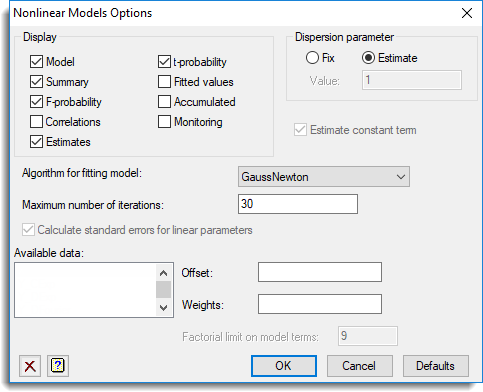Select the output to be generated in a Nonlinear regression analysis.

Display
| Model | Details of the model that is fitted |
| Summary | Summary analysis of variance/deviance |
| F-probability | Approximate F-probabilities for variance/deviance ratios |
| Correlations | Correlations between the parameter estimates |
| Estimates | Estimates of the parameters in the model |
| t-probability | Approximate t-probabilities for the parameter estimates |
| Fitted values | Table containing the values of the response variate, fitted values, standardized residuals and leverages |
| Accumulated | Analysis-of-variance/deviance table containing a line for each change in the fitted model |
| Monitoring | Monitoring information at each iteration |
Dispersion parameter
Controls whether the dispersion parameter for the variance of the response is estimated from the residual mean square of the fitted model, or fixed at a given value. The dispersion parameter (fixed or estimated) is used when calculating standard errors and standardized residuals. In models with the binomial, Poisson, negative binomial, geometric and exponential distributions, the dispersion should be fixed at 1 unless a heterogeneity parameter is to be estimated.
Estimate constant term
If the estimation includes a linear parameter, you can specify whether to include a constant in the model.
Algorithm for fitting model
A list of different algorithms available for fitting a nonlinear model.
Maximum number of iterations
Specifies the maximum number of cycles in the iterative estimation process.
Calculate standard errors for linear parameters
For a model including linear parameters, you can specify the standard errors for each of the linear parameters to be evaluated.
Offset
A nonlinear model can be modified to take account of a fixed contribution to the linear effects for each unit, supplied in a variate referred to as the offset.
Weights
A variate of weights can be supplied to give varying influence of each unit on the fit of the model. This would usually correspond to a known pattern of variance of the observations, when the weights would be the reciprocal of the variances.
Factorial limit on model terms
For a model including linear parameters, you can control the factorial limit on model terms to be generated when you use model-formula operators like *. Th default is to include all interactions, up to those involving nine variates or factors. (You cannot ask for more than nine.)
See also
- Nonlinear Models menu
- Save Options
- Change Model
- Nonlinear Models Generate Expression
- Nonlinear Models Parameter Settings
- Nonlinear Models Reorder Expression List
- Nonlinear Quantile Regression menu
- Standard Curves for information on general options and other curves
- Standard Curves with Correlated Errors menu.
- Exponential Curves
- Fourier Curves
- Gaussian Curves
- Growth Curves
- Rational Curves
- Examples of Standard Nonlinear Curves
- FITCURVE directive
- FITNONLINEAR directive
- FIT directive
- RQNONLINEAR procedure
- MINIMIZE procedure
- SIMPLEX procedure